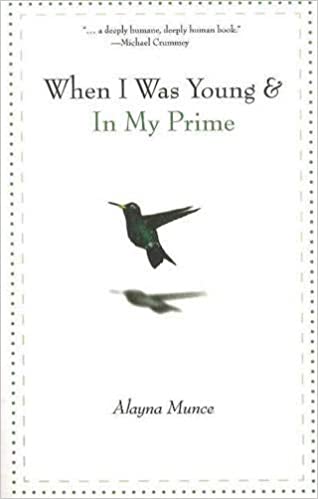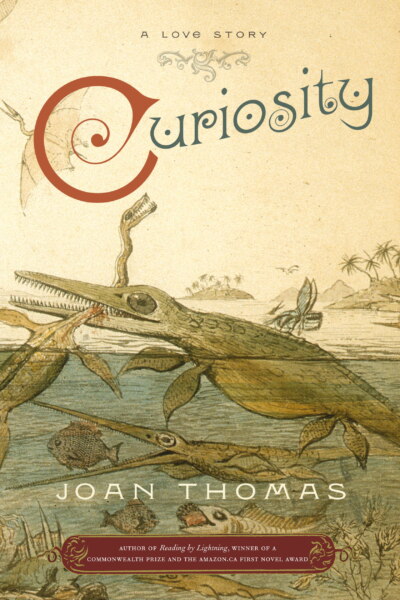It’s such a pleasure to read a good book. I’ve got two to recommend: Alayna Munce’s When I Was Young & In My Prime and Joan Thomas’s Curiosity.
I don’t know what the heck I was doing in 2005 that I missed When I was Young & In My Prime. I’m trying to think back. Oh yeah, I was recovering from cancer. So I guess that explains it. But this book is everything I love—a multi-generational tale told in multiple points of view. This is exactly what I studied throughout my MFA, and how I missed it then is another puzzle. It will forever be listed in the same category as The Stone Diaries and Fall On Your Knees. So it’s THAT good. But it just goes to show, some of the best books just don’t get onto our radar.

What do I love about this book? Munce is a poet and it shows in her exacting and evocative prose. She allows her characters to make mistakes, to grow, to fall back, to grow again. They are so real. There is such a great depth of kindness depicted here. For example, the main character has a job bathing seniors in the nursing home. It is the every-day-ness of kindness that I love in this book, the call to deep human connection and the depiction of the frailty of it. I love the failure of the characters to always know exactly what should come next. This is to true to life.
Munce also has an interest in how memory works in this book, a a particular obsession of mine having lost most of it. The way she depicts the loss of memory, both from an individual’s mind and from collective history is thought provoking and so very real.
I had a friend recently say, “We don’t know how to die anymore.” She meant that we have forgotten or lost sight of the rituals around death. We don’t know how to let someone go. We’ve lost the grace in it. Munce is a writer who knows that grace. I feel the loss of the main character’s grandfather as though he were my own. To create empathy so skillfully is a true accomplishment.
And on the FAF scale (feminist as fuck scale) it ranks a 5 out of 5.
Joan Thomas’s latest novel, Five Wives is what I should be reading, but I had to go back first to Curiosity. This book slays.

It is the imagined story of real life Mary Anning, who sold curiosities from the sea that she found in the cliffs by the town of Lyme Regis. It is set in the time before Darwin’s theories were accepted and her discoveries are inexplicable given the understandings of the day. Ammonites and other fossils are sold as charms, with equally charming stories about what protections they offer the buyer. A particular find referred to as “Devil’s toes” is a favourite of mine, and I have no doubt that it is also historically accurate. That is the kind of faith Thomas earns in the reader.
What Thomas gives us is a ripper of a tale: an impoverished girl making her living, making her way, going beyond her station—however you want to put it—within a world where men continually use her discoveries and her knowledge for their own advancement. She is never given proper credit. As Thomas notes in the Author’s Note, the effort to establish Mary Anning’s scientific credentials did not begin until the 1930s. Yet she emerges as a figure more worthy of the reader’s respect than any of those “scientists” in the fields of geology and “undergroundology” that are all around her. She dreams of being recognized by the Royal Society, but such recognition will never happen and she becomes a kind of Pygmalion character, too fancy in her learning and speech to be fully accepted by townsfolk and too poor to ever be accepted by the upper class.
The book gets a five star FAF rating from me. Like all the best historical fiction, it is oddly contemporary in its concerns. Women still struggle for the recognition their work deserves. And the class issues gives it that “intersectionality” that is part of real life. The author has a sociological eye that I appreciate. Her characters are set in a society in a time and place and we learn what the rules are and how they are all constrained by them.
What is particularly compelling to me is the way in which Thomas weaves the details of her research into a compelling story that never feels weighed down by that same research. From the use of common terms of the time and the occasional drift into contemporaneous dialect, to the research of figures like Lamarck and the actual letters and imagined letters of Henry De La Beche, to the explication of theological issues of the day, it all serves to move the story and enrich our sense of the characters. It is a tour de force.
I have had this book in my possession since 2010, but it was not until now that I read it. This happens sometimes. Now, on to Five Wives! But first I have to edit my own book. Here’s hoping it doesn’t take me ten years to get back to Five Wives.
